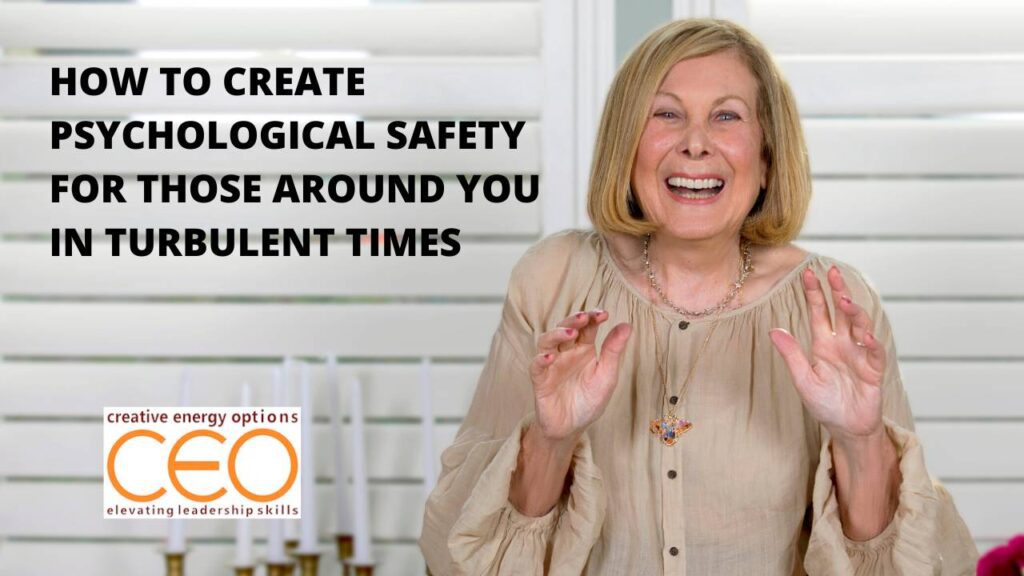
Summary: Leadership education means addressing the needs of all employees to create psychological safety. This is vital for all leaders to consider during uncertainty and radical change.
Dear Dr. Sylvia,
Everyone seems to be living in a world of overwhelm and distress.
As the leader of a vast work team, I want to help and create an environment of less stress.
In summary, is this even possible?
Signed,
Optimist Forever
Dear Optimist Forever,
You have a great outlook. Optimism means that you like to optimize the good in every situation.
Yay for you!
Therefore, here is your homework for today.
Firstly, think about leaders you’ve known in your life or from history that you feel you could follow anywhere. Then consider those you looked at and said, “Not for me. I’m out of here.â€
Make two lists and write just one short sentence about why you would follow some and avoid others. You can refer to the list as I continue with ways to create psychological safety for your team.
Moving on, here are some tips for leaders in times of uncertainty and stress.
In other words, there’s a big difference between leaders in name only and those you want to hang out around and learn from.
Above all, as a leader, you need to practice. That means practicing leadership all the time.
Here’s how to get ready for times of stress and anxiety.
Therefore, when a tough time comes, you’re ready for it.
For example, it’s no different from learning to play the guitar or a piano. It’s like getting ready for a marathon.
Above all, you need to practice before the time comes when difficulties are staring you in the face.
Further, as a leader, how will you handle challenging situations? Think about when people look at you and wonder if you have the skills.
Indeed, you can almost hear them thinking, “What will he or she do to make a difference here?â€
Can you prepare your company for tough times?
Therefore, I’d like to talk first about psychological safety. This concept developed by Amy Edmondson, a professor at Harvard Business School, has gained traction. Her work takes safety at work to the next level.
For example, there are many specific regulations that OSHA, The Occupational Safety and Health Administration, require. It’s responsible for conducting research and making recommendations to prevent work-related injury and illness. Thus, you go into offices, and there are often signs saying they are OSHA compliant.
Therefore, there is a sense of comfort going into most offices. Indeed, there are floors on which you can’t slip and slide. And you can feel relieved that boxes won’t fall in your head.
What are guardrails for psychological safety?
Likewise, it should be the same with psychological safety.
For example, you need to create some warning signs and guardrails. Then, when crises or surprises happen, you can say to your employees, “No, no, don’t go over there. You could slip and slide and fall there.†That’s your job. That’s what you, as a leader, have signed up for.
Consequently, how do you develop the emotional muscle that is needed?
ln addition, you practice, practice, and practice.
The use of language to develop psychological safety
For instance, one of the first things you can do is look at the research about language and communication.
Therefore, I’m going to give you one quick tip today.
For example, here is a study with college students as participants. Please picture this.
Firstly, the students are standing in two lines. There are two doors. They have to go into a room and do something divided into random groups. I’ll tell you what this something is in a minute.
Then there’s a back door, and they go out.
After that, they all congregate together in the back area. It’s a grassy, green outside area, pleasant and relaxed.
That’s it! In each room, the researchers asked them to drink iced tea.
In other words, no big deal, right?
The words you use matter immensely.
Most importantly, pay attention to communication.
For example, group one is told, “May we pour the iced tea, so the glass is half-full.â€
In the same vein, the other group is told, “Can we pour the iced tea, so the glass is half-empty.â€
Nothing else was said.
To clarify, the students drink their iced tea in each room, and off they go.
Consequently, they are all outside milling around, wondering what is next.
After that, the researchers came out with pitchers and glasses. They asked people who would like more iced tea.
Now it gets interesting.
After that, here is what they found. I’ll bet some of you have already guessed this.
To sum up, the students in the group where the iced tea went into half-empty glasses were thirstier. Those in the half-full room did not want to drink more. They were more satisfied.
Is your glass half-full or half-empty? Only YOU can choose.
So, what do you learn from that?
In other words, is it a mindset thing? Can we feel full or thirsty just because someone tells us something?
That is to say, do we have the ability to help people see things differently? In this case, from either a negative or a more positive place?
Moreover, I’m not talking about being a denier or ignoring situations. I’m talking about how we help people stay in that place where they feel good enough to get something done.
As a result, can we honestly create psychological safety just by our words?
Positive talk can be a powerful motivator.
So, think about it when you’re talking to people. Speak in the half-full glass rather than the half-empty glass language. Then people have fewer needs.
I bet, as you look at the list you created of leaders you love, and those you don’t want to be around, the leaders you love are more positive, more, as you would say, optimistic.
Most importantly, take this research study as a helpful tip about the words to create psychological safety.
In addition, I developed a quiz to see how you presently handle the impact of stress. Then you may consider taking my online program called “Stress Busters.” It has excellent research about food, exercise, music, movement, how we communicate, and the underlying reasons why we respond to stress the way we were taught as youngsters.
Please remember that we’re all in these challenging times together. MY philosophy is, ‘No one wins unless we all do.’ Maybe, just maybe, that’s the right direction.
Thank you so much and here’s to your success.
Sylvia
PS. Here’s the video for everyone who is a visual learner. AND go to www.ceoptions.com for a free copy of the introduction to my new book “Invisible Stress (It’s NOT What YOU Think!)”


